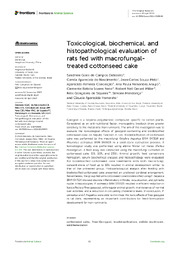Toxicological, biochemical, and histopathological evaluation of rats fed with macrofungaltreated cottonseed cake.
Toxicological, biochemical, and histopathological evaluation of rats fed with macrofungaltreated cottonseed cake.
Author(s): DEBOLETO, S. G. de C.; NASCIMENTO, C. A. do; MELO, J. C. S.; CONCEIÇÃO, A. A.; ARAUJO, A. P. F.; SOARES NETO, C. B.; MILLER, R. N. G.; SIQUEIRA, F. G. de; MENDONCA, S.; HONORATO, C. A.
Summary: Gossypol is a terpene-polyphenolic compound specific to cotton plants. Considered as an anti-nutritional factor, monogastric livestock show greater sensitivity to this metabolite than ruminants. The aim of this investigation was to evaluate the toxicological effects of gossypol-containing and biodetoxified cottonseed-cake on hepatic function in rats. Biodetoxification of cottonseed cake was performed by the macrofungi Fistulina hepatica BRM 047114 and Pleurotus ostreatus BRM 055505 in a solid-state cultivation process. A toxicological study was performed using albino Wistar rat males (Rattus norvergicus). A feed assay was conducted using the macrofungi cultivated on cottonseed cake (5%, 15%, and 25%). Animal growth, feed conversion, hemogram, serum biochemical analyses and histopathology were evaluated. For biodetoxified cottonseed cake treatments with both macrofungi, concentrations of feed up to 15% resulted in animal development similar to that of the untreated group. Histopathological analysis after feeding with biodetoxified cottonseed cake presented an unaltered cordonal arrangement. Nevertheless, the group fed with cottonseed cake biodetoxified using F. hepatica BRM 047114 showed discrete inflammatory infiltrate, vacuolization, and pyknotic nuclei in hepatocytes. P. ostreatus BRM 055505 resulted in efficient reduction in toxic effects of free gossypol, with regular animal growth, maintenance of normal liver activities, and a reduction in circulating cholesterol levels. In conclusion, P. ostreatus and F. hepatica were able to minimize the toxic effects of free gossypol in rat diets, representing an important contribution for feed-formulation development for non-ruminants.
Publication year: 2024
Types of publication: Journal article
Unit: Embrapa Agroenergy
Observation
Some of Embrapa's publications are published as ePub files. To read them, use or download one of the following free software options to your computer or mobile device. Android: Google Play Books; IOS: iBooks; Windows and Linux: Calibre.
Access other publications
Access the Agricultural Research Database (BDPA) to consult Embrapa's full library collection and records.
Visit Embrapa Bookstore to purchase books and other publications sold by Embrapa.

